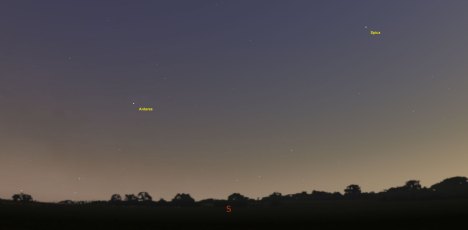But once you feel confident you have this triangle identified, face South and look for our other July guidepost star, Antares. The name “Antares” can be translated as “rival of Mars” and is an indication of the star’s redness. If this isn’t immediately apparent to you, compare it to blue/white Vega. Or, if you have been studying the sky for several months, compare it to the icy blue of Spica, now in the southwest sky. (Remember – you reach Spica by following the arc of the Big Dipper’s handle first to Arcturus, then continuing on to Spica.
Stellarium's depiction of the twilight sky looking due south in July from mid-northern latitudes. Antares is the bright star to the left (east) and Spica the other one.
The image above shows how the twilight sky to the south looks in early July. The lower star on the left is Antares, the one to the right is Spica. There’s about 45 degrees between these two, so as it gets fully dark you’ll notice Antares is almost due South. In northern latitudes Antares is quite low – here in Westport, MA. it is only 22 degrees above the southern horizon when it transits (about 10 pm in early July) – just half as high as Polaris which, of course, anchors the northern sky. (No – Antares is not the southern pole star. It is a long way from it. In fact, there is no bright star marking the southern celestial pole, but if there were you would have to be in the southern hemisphere to see it. Antares is less than one third of the way to the South Celestial Pole. )
As the sky gets fully dark on a July evening, Antares will be due South and be the core of one of the constellations that really does resemble it’s name – Scorpius, the scorpion.


Tidak ada komentar:
Posting Komentar